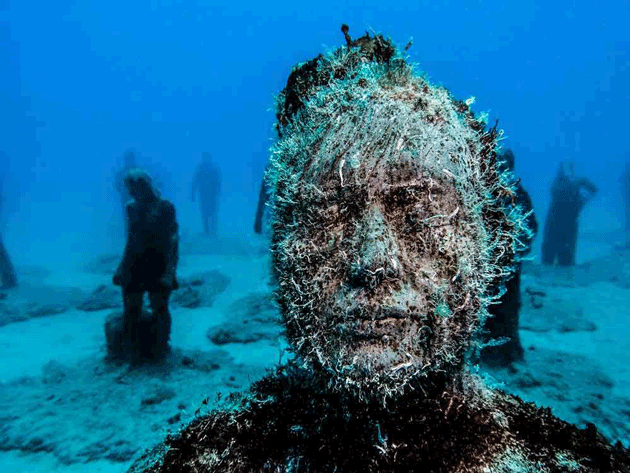British artist and diving sculptor Jason deCaires Taylor creates aquatic sculptures and installations that shed light on the decaying environments of coastal areas around the world. His contemporary artwork raises awareness to protect the ocean and its aquatic ecologies. Taylor’s work uses artificial reefs and specially constructed sculptures made from pH-grade cement that are free from dangerous toxins, allowing the installations to be an enduring part of the local ecosystem. His work also portrays the forms of real people engaging in everyday tasks, referencing various social and humanitarian issues.
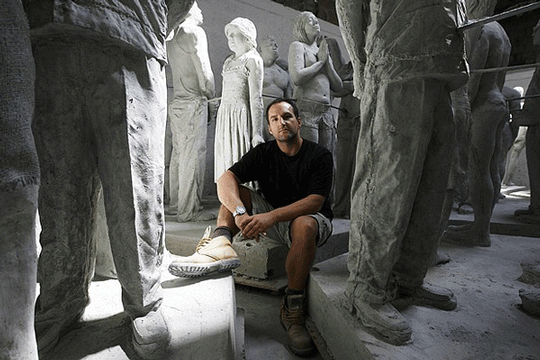
A great deal of consideration is paid to all of Taylor’s art sculptures, including their location and establishment. The location of his sculptures is closely considered in order to optimize positive environmental effects. Most of Taylor’s sculptures are installed away from natural reefs, primarily in areas of desolate sandbanks to enhance sustainability and attract tourists away from fragile habitats where they can unintentionally cause more harm than good. His artificial sculptural reefs are produced in collaborative efforts with marine scientists to maximize their impact on the ecosystem. The benefit of these sculptures is even greater, as Taylor’s work has provided economic benefits to local fishermen who also work as museum guides to bring tourists to the underwater galleries. The money raised from the admission fees of the exhibitions provides funding for more environmental restoration and the implementation of sufficient preservation legislation for aquatic ecosystems.
Jason deCaires Taylor’s work is located in oceans around the world, specific to the global issues that impact aquatic ecologies. His most notable work is the Museo Atlantico, a series of over 300 sculptures immersed in the coast of Lanzarote, Spain. Museo Atlantico was installed in 2016 and is the first underwater art museum in Europe and the Atlantic Ocean. It is located within the UNESCO World Biosphere Reserve of Lanzarote and is visible to divers and snorkelers. The Museo Atlantico was designed to establish an artificial reef on a large scale. It contains the Rubicon, a group of 35 human figures walking towards a wall, the famous Raft of Lampedusa, a symbol of the current global refugee crisis, and a group of children in small brass boats named Los Jolateros. The project establishes a strong connection between art and nature, creating an installation that will endure for hundreds of years. It is a transforming exhibition that alters the texture of the sculptures as marine life shifts.
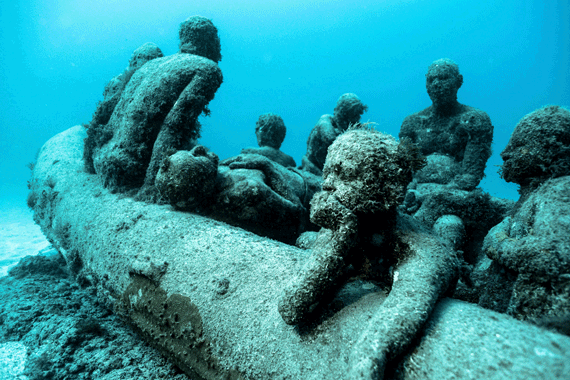
The Sculpture Coralarium is another remarkable artwork by Taylor located in Sirru Fen Fushi in the Maldives. The sculpture is a semi-submerged tidal art gallery illustrating a collection of sculptural artworks existing in three different natural conditions. The entire installation is designed to function through three components, with some sculptures sitting on top of the cube, and others sitting below the waterline. In order to access this extraordinary structure, tourists have to snorkel or swim 500 ft along an underwater coral path that is surfaced with planted corals. The artwork demonstrates the notion that everything, from our natural world to organic constructs, is related. Taylor’s sculptures displayed in the Coralarium are all constructed from the life casts of real people in order to symbolize the human connection to the natural environment. One of the sculptured characters is Young Charles, seated at the entrance with his legs hanging over the side. His stance reveals how unimpressed he is with the world beneath him, while the adults are oblivious to the reality around them. Coralarium is a unique initiative that places importance on the disaster beneath the surface of the ocean that is affecting the survival of the Maldives, constructing a bridge between the surface and the sea.
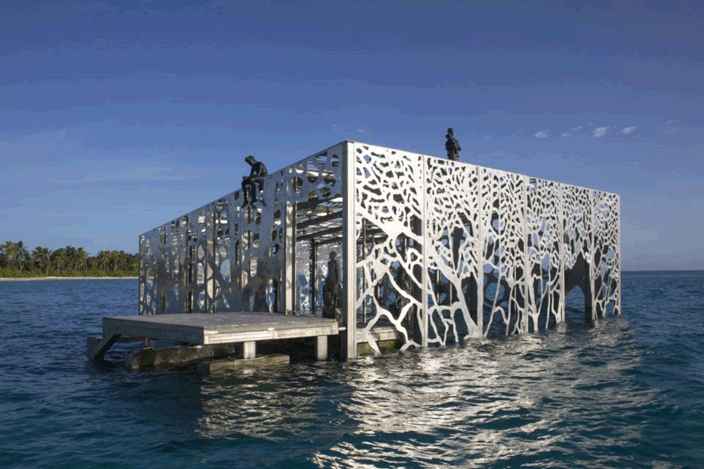
Taylor’s outstanding sculpture The Coral Greenhouse is an underwater sanctuary for endangered marine species. His construction sits around 50 miles from Townsville, Australia on the sandy floor of the John Brewer Reef. The Coral Greenhouse was made with corrosion-resistant stainless steel and pH neutral compounds to stimulate coral development and absorb into the oceanic atmosphere so that animals may easily enter into it. It is Taylor’s first-ever underwater building and the largest installation in Australia’s recently launched Museum of Underwater Art in the Great Barrier Reef. The sculpture raises awareness and appreciation of the Great Barrier Reef and its biodiversity, creating a fascinating dive spot for visitors. Many sculptures of children and locally-inspired gardens are installed in and around the Coral Greenhouse to educate visitors about the important connection with the marine environment. The children are shown to be cradling planters, gazing into microscopes, and monitoring the vulnerable environment. They are the protectors of the Great Barrier Reef, fostering a precious relationship with the natural ecosystem both surrounding them and acknowledging its fragility and need for protection.
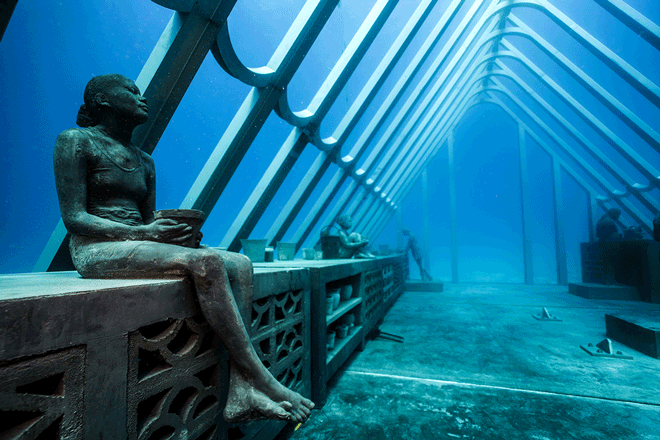
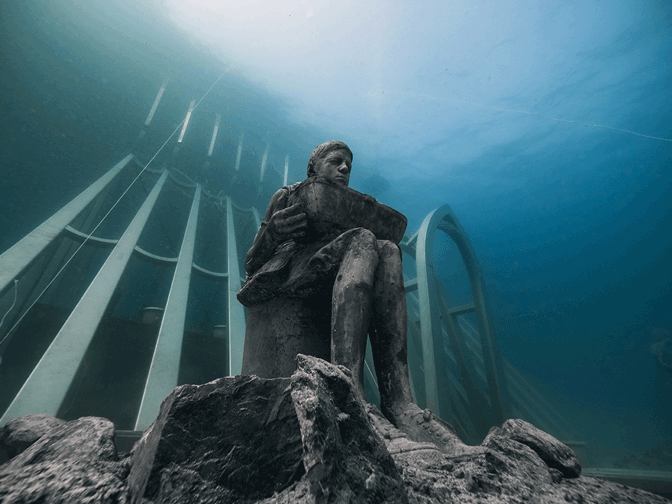
In his sculpture The Rising Tide, Taylor depicts several working horses with riders on the banks of the River Thames in Central London. It is situated right across from the Houses of Parliament and is primarily aimed at the fossil fuel industry. Unlike many of Taylor’s other works, this one is viewable from the land. The piece is exposed by the rise and fall of the tide, interacting with the natural environment of the Thames river. The four life-size horses stand as a metaphor for the origins of industrialization and as a warning of the grim future, it has created through its portrayal of the four horsemen of the apocalypse. The heads of the horses have been replaced by an oil well pump. They convey an attitude of insensitivity and ignorance in the face of the ongoing climate crisis, while the young riders represent hope in effecting future change. The sculptures emphasize the urgency of the issue and the need for action.
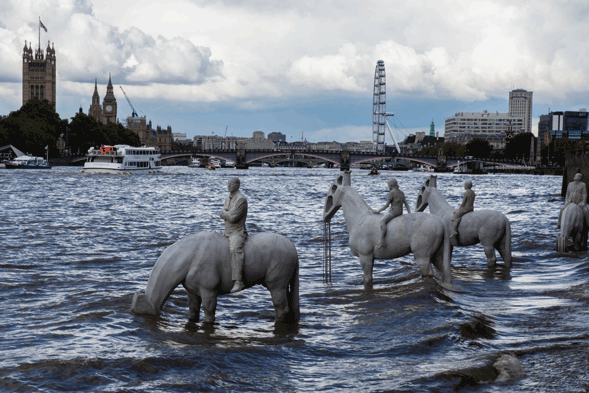
Jason deCaires Taylor is a revolutionary artist whose work exposes audiences to innovative perspectives and ideas on ocean conservation and global environmental consciousness. His artwork is infused with abstract themes and social commentaries that have the potential to bring on meaningful conversation and tangible change. He exhibits intentionality in his sculptures, introducing viewers to the vulnerable conditions of marine ecosystems and the role that humans can play in maintaining their health or their destruction.
